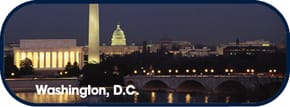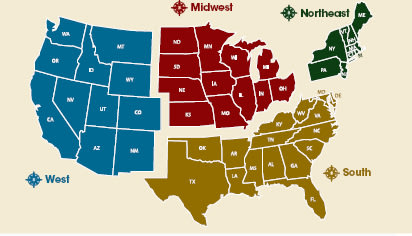American Demographics 2011
A region-by-region report on business and the economy
Welcome to EB's third annual regional report on business and the economy in each of the four U.S. regions. In addition to outside business resources, EB also tapped you, our readers, in an online survey completed last month.
Both optical sales trends and ECP attitudes are more positive than those in many sectors. In the EB survey, 51 percent of you reported first quarter 2011 sales were up over 2010. And, 47 percent of you said 2010 sales were better than in 2009.
Here's a closer look at the trends.
■ THE ECONOMY. “The economy just hit a brick wall,” Paul Ashworth, chief U.S. economist at Capital Economics, told The New York Times on June 3. “It's almost as if it came to a complete standstill. After several months of strong job growth, hiring slowed sharply [in May, as did stock and home prices], raising concerns about the strength of the recovery.”
■ RETAIL. The good news? Kantar Retail, a research/consulting firm, reports same-store sales were up 5.7 percent in May, and 5.4 percent during March/April (compared with 2.7 percent in 2010).
The shining star is luxury; the challenge is the lower end. As Richard Hastings, a consumer strategist at Global Hunter Securities, told Reuters, “Retailers that cater to lower-income consumers are expected to struggle throughout the year, since their customers are more affected by unemployment and higher food and fuel prices.”
■ CONSUMERS. The Consumer Confidence Index showed that U.S. consumers registered increasing pessimism for the three months ending May 31.
■ SPENDING. “A big issue is to what extent will the jump in fuel prices continue to take the edge off growth,” says Frank Badillo, senior economist with Kantar Retail. “High fuel prices affect shopping behavior.”
■ FASHION. “There is such a switch into color right now because consumers want to be hopeful. It affects every classification. It's really bright and fun,” reports Roseanne Morrison, fashion director, The Doneger Group, a trend and color forecasting service.
■ FRAMES. With plastic eyewear trending up in the East and West, acetates continue their quest for equality with metal frame styles. But thanks to metal sales in the Midwest and South, the material dominates frame sales—but with less than a 50 percent share for the first time in EB's study. Rimless also continues strong, representing 13 percent of the frames dispensed by respondents.




A big survey story is the slip of the sunglass. Second-pair sunglass sales rule but have lost some ground to casual eyewear, clips, and options such as readers and computer glasses.
■ LENSES. Nationally, free-form/digitally produced lens sales show a slight dip in this year's survey, from 25 percent of lens sales in 2010 to 22 percent in 2011. Lens materials experiencing the most growth are 1.67 and Trivex. This year, as last, AR is by far and away the best-selling lens treatment.
One of 2010's biggest growth categories, polarized lenses, has decreased slightly among respondents, while photochromic sales have increased in the Northeast but decreased in the South. One possibility: polarized sales may have migrated to photochromic sales with the ramp-up of polarized photochromics.
PAL sales have increased to 71 percent of multifocal sales in 2011 compared with 69 percent last year.
■ EDGING. Practices that do in-office finishing are now edging more lenses in-house or at least doing the same amount of on-site work. The lenses most often processed in-office are, in order, CR39, poly, and high index.
Overall, however, nearly half of respondents (46 percent) indicated they do no in-house edging. Their reasons: Limited space, satisfaction with current lab, and uncertainty about return on investment.
The good news? Nearly a third (31 percent) of those not edging in-office report plans to add it on.



